
Lake Toba is a large natural lake in North Sumatra, Indonesia, occupying the caldera of the Toba supervolcano. The lake is located in the middle of the northern part of the island of Sumatra, with a surface elevation of about 900 metres (2,953 ft), the lake stretches from 2.88°N 98.52°E to 2.35°N 99.1°E. The lake is about 100 kilometres long, 30 kilometres (19 mi) wide, and up to 505 metres (1,657 ft) deep. It is the largest lake in Indonesia and the largest volcanic lake in the world. Toba Caldera is one of twenty geoparks in Indonesia, and was recognised in July 2020 as one of the UNESCO Global Geoparks.

Sumatra is one of the Sunda Islands of western Indonesia. It is the largest island that is fully within Indonesian territory, as well as the sixth-largest island in the world at 482,286.55 km2 (182,812 mi.2), including adjacent islands such as the Simeulue, Nias, Mentawai, Enggano, Riau Islands, Bangka Belitung and Krakatoa archipelago.

Indonesia is a country with many different tribes and ethnic groups, and its music is also very diverse, coming in hundreds of different forms and styles. Every region has its own culture and art, and as a result traditional music from area to area also uniquely differs from one another. For example, each traditional type of music is often accompanied by its very own dance and theatre. Contemporary music scene have also been heavily shaped by various foreign influences, such as America, Britain, Japan, Korea, and India.
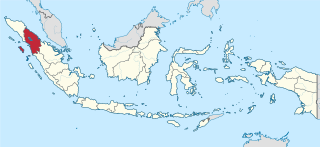
North Sumatra, also called North Sumatra Province, is a province of Indonesia located in the northern part of the island of Sumatra, just south of Aceh. Its capital and largest city is Medan on the east coast of the island. It is bordered by Aceh on the northwest and Riau and West Sumatra on the southeast, by coastlines located on the Indian Ocean to the west, and by the Strait of Malacca to the east.
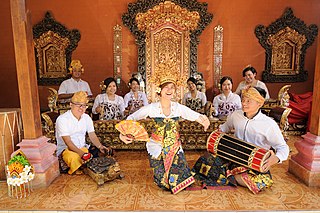
The Music of Bali, Bali is an Indonesian island that shares in the gamelan and other Indonesian musical styles. Bali, however, has its own techniques and styles, including kecak, a form of singing that imitates the sound of monkeys. In addition, the island is home to several unique kinds of gamelan, including the gamelan jegog, gamelan gong gede, gamelan gambang, gamelan selunding and gamelan semar pegulingan, the cremation music angklung and the processional music bebonangan. Modern popular styles include gamelan gong kebyar, dance music which developed during the Dutch occupation and 1950s era joged bumbung, another popular dance style. In Balinese music you can also hear metallophones, gongs and xylophones.

The Music of Java embraces a wide variety of styles, both traditional and contemporary, reflecting the diversity of the island and its lengthy history. Apart from traditional forms that maintain connections to musical styles many centuries old, there are also many unique styles and conventions which combine elements from many other regional influences, including those of neighbouring Asian cultures and European colonial forms.

A gamelan gadhon is an ensemble consisting of the 'soft' instruments of the Javanese gamelan. This can include rebab, gendér, gendér panerus, voice, slenthem, suling, siter, gong, kempul, kenong and kendhang.
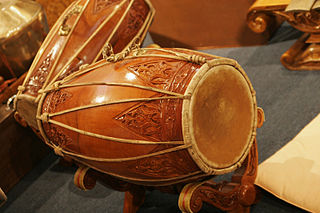
A kendang or gendang is a two-headed drum used by people from the Indonesian Archipelago. The kendang is one of the primary instruments used in the gamelan ensembles of Javanese, Sundanese, and Balinese music. It is also used in various Kulintang ensembles in Indonesia, Brunei, Malaysia, Singapore, and the Philippines. It is constructed in a variety of ways by different ethnic groups. It is related to the Indian double-headed mridangam drum.
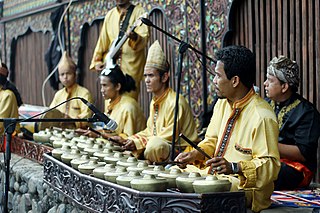
Talempong is a traditional music of the Minangkabau people of Western Sumatra, Indonesia. The talempong produce a static texture consisting of interlocking rhythms.

Gamelan siteran is a casual style of gamelan in Java, Indonesia, featuring portable, inexpensive instruments instead of the heavy bronze metallophones of a typical gamelan. A typical group consists of varieties of siter, kendang (drum), and a large end-blown bamboo tube or a gong kemodhong, functioning as a gong ageng. A full group has a celempung, siter, siter panerus, siter slenthem, kendhang ciblon, and gong kemodhong. It is typically accompanied by singing as well. The instruments are often homemade, something which is impossible with the more characteristic gamelan instruments. Performances are usually of pieces from the standard Javanese gamelan repertoire.

Kroncong is the name of a ukulele-like instrument and an Indonesian musical style that typically makes use of the kroncong. A kroncong orchestra or ensemble traditionally consists of a flute, a violin, at least one, but usually a pair of kroncongs, a cello in Pizzicato style, string bass in pizzicato style, and a vocalist. Kroncong originated as an adaptation of a Portuguese musical tradition, brought by sailors to Indonesian port cities in the 16th century. By the late 19th century, kroncong reached popular music status throughout the Indonesian archipelago.

The Asahan River is one of the principal rivers in North Sumatra, Indonesia, that begins in Porsea, Toba Regency near the southeast corner of Lake Toba.
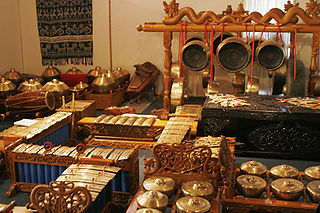
A gong chime is a generic term for a set of small, high-pitched bossed pot gongs. The gongs are ordinarily placed in order of pitch, with the boss upward on cords held in a low wooden frame. The frames can be rectangular or circular, and may have one or two rows of gongs. They are played by one to four musicians, each using two padded sticks to strike them. They are an important instrument in many Southeast Asian musical ensembles, such as Indonesian gamelan, kulintang, or Thai pi phat. For this reason, such ensembles are sometimes called "gong chime ensembles" or "gong chime orchestras," and the broad variety of music "gong chime music."

Bamboo's natural hollow form makes it an obvious choice for many musical instruments. In South and South East Asia, traditional uses of bamboo the instrument include various types of woodwind instruments, such as flutes, and devices like xylophones and organs, which require resonating sections. In some traditional instruments bamboo is the primary material, while others combine bamboo with other materials such as wood and leather.

Batak cuisine is the cuisine and cooking traditions of Batak ethnic groups, predominantly found in Northern Sumatra region, Indonesia. Batak cuisine is part of Indonesian cuisine, and compared to other Sumatran cuisine traditions, it is more indigenously preserved. One characteristic of Batak cuisine is its preference to andaliman as the main spice. That is why andaliman in Indonesia sometimes dubbed as "Batak pepper".

Pannai, Panai or Pane was a Buddhist kingdom located on the east coast of Northern Sumatra that existed between the 11th and 14th centuries. The kingdom was located on the Barumun River and Panai River valleys, in today's Labuhan Batu and South Tapanuli regencies. Because surviving inscriptions and historical records of this period are scarce, the kingdom is among the least known political entities in Indonesian history. Historians suggest that Pannai was probably a principality or a vassal allied under the Srivijayan mandala and later to Dharmasraya kingdom.

The tube zither is a stringed musical instrument in which a tube functions both as an instrument's neck and its soundbox. As the neck, it holds strings taut and allows them to vibrate. As a soundbox, it modifies the sound and transfers it to the open air. The instruments are among the oldest of chordophones, being "a very early stage" in the development of chordophones, and predate some of the oldest chordophones, such as the Chinese Se, zithers built on a tube split in half. Most tube zithers are made of bamboo, played today in Madagascar, India, Southeast Asia and Taiwan. Tube zithers made from other materials have been found in Europe and the United States, made from materials such as cornstalks and cactus.

A tifa totobuang is a music ensemble from the Maluku Islands, related to the kulintang orchestra. It consists of a set of a double row of gong chimes known as the totobuang and a set of tifa drums. It can also include a large gong.

Gordang sambilan is a kendang musical instrument originating from North Sumatra, Indonesia. Gordang sambilan consists of nine relatively large and long drums made of ingul wood and played by four people. The size and length of the nine drums are stratified, starting from the largest to the smallest.

Music of Minang is a traditional and living genre of Indonesian music that grows and develops in the Minangkabau culture area. Music whose origins are related to Malay Music is generally played by musical instruments such as Talempong, Saluang, Minang rebab, Serunai, Tmbourine, Aguang, Gandang, and Violin. Minang music is also played to accompany various dances such as the Pasambahan dance and the Piring dance.


















